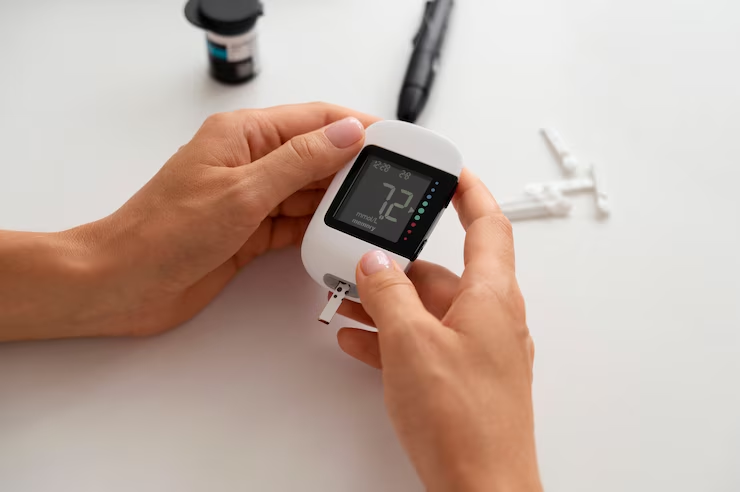Normal Fasting Glucose Levels: maintaining healthy blood sugar is essential for overall wellness. Fasting glucose levels—the amount of sugar in your blood after not eating for at least 8 hours—are especially important because they reveal how well your body manages blood sugar without the influence of recent meals. High or low levels can be early indicators of diabetes or other metabolic issues.
Understanding normal fasting glucose levels is essential for maintaining long-term health and preventing chronic conditions like diabetes. Fasting glucose refers to the amount of sugar in your blood after not eating for at least eight hours—typically tested first thing in the morning. These levels serve as a crucial marker for how well your body regulates blood sugar during rest. In this comprehensive guide, we’ll explore what constitutes normal fasting glucose levels, why they are so important, and the best ways to manage them naturally.
Whether you’re someone trying to prevent diabetes, manage prediabetes, or simply want to stay informed about your health, knowing your fasting glucose numbers can help you take proactive steps. A normal fasting glucose level usually ranges between 70 and 99 mg/dL. Readings above this range can signal insulin resistance or early signs of metabolic issues.
By adopting healthy habits such as eating a balanced diet, staying physically active, sleeping well, managing stress, and drinking plenty of water, you can significantly improve your glucose control. With expert-backed insights and practical tips, this guide empowers you to maintain normal fasting glucose levels and support overall metabolic health naturally—without relying on drastic diets or medication.
What Are Normal Fasting Glucose Levels?

Fasting blood glucose is typically tested in the morning before breakfast. According to the American Diabetes Association:
- Normal: 70–99 mg/dL (milligrams per deciliter)
- Prediabetes: 100–125 mg/dL
- Diabetes: 126 mg/dL or higher on two separate tests
Normal fasting glucose levels are a crucial indicator of how efficiently your body manages blood sugar during periods without food—typically overnight. When you fast for at least 8 hours, your body relies on internal glucose regulation mechanisms, primarily controlled by insulin. This makes fasting glucose levels a reliable marker for detecting early metabolic changes.
Consistently elevated fasting glucose levels can be one of the earliest warning signs of insulin resistance, a condition where the body’s cells no longer respond properly to insulin. Over time, this resistance can progress into prediabetes or even type 2 diabetes if not addressed. While the normal fasting glucose level generally ranges from 70 to 99 mg/dL, readings between 100 and 125 mg/dL may indicate prediabetes, and levels above 126 mg/dL typically signal diabetes.
Monitoring your normal fasting glucose levels regularly can provide valuable insight into your metabolic health and help you take preventative action. Factors like poor diet, lack of physical activity, high stress, and insufficient sleep can all influence your fasting blood sugar levels. By making healthy lifestyle adjustments and tracking your numbers, you can work toward maintaining optimal fasting glucose levels and reducing your long-term risk of chronic conditions like diabetes and heart disease
Why Monitoring Fasting Glucose Matters
Blood glucose affects everything from your energy levels to your risk of chronic disease. Elevated fasting glucose can:
- Damage blood vessels and nerves
- Increase inflammation
- Lead to insulin resistance
- Increase risk for heart disease, kidney issues, and vision problems
Monitoring these levels regularly helps you catch problems early—and possibly reverse them through lifestyle changes.
Top 8 Tips to Maintain Normal Fasting Glucose Levels
Let’s explore the top 8 science-backed tips to help you maintain healthy fasting glucose levels naturally.
1. Prioritize a Balanced Diet

What you eat plays a vital role in managing your normal fasting glucose levels. One of the most effective ways to keep blood sugar in check is by choosing foods with a low glycemic index (GI). The glycemic index measures how quickly a food raises blood sugar levels. Low-GI foods are digested and absorbed more slowly, resulting in gradual increases in blood sugar rather than sharp spikes.
Incorporating more low-GI foods into your diet—such as leafy greens, whole grains, legumes, berries, and nuts—can help stabilize your normal fasting glucose levels over time. These foods provide sustained energy, reduce cravings, and improve insulin sensitivity. In contrast, high-GI foods like white bread, sugary cereals, pastries, and soda can lead to rapid spikes in glucose, followed by crashes that may trigger hunger and overeating.
Maintaining normal fasting glucose levels is especially important if you’re managing or trying to prevent prediabetes or type 2 diabetes. A balanced diet focused on fiber-rich whole foods, healthy fats, and lean proteins supports better blood sugar regulation and reduces the risk of chronic disease. Always read food labels, control portions, and combine carbs with protein or fat to slow glucose absorption and promote long-term metabolic health.
Foods to include:
- Whole grains (quinoa, brown rice, oats)
- Leafy greens and non-starchy vegetables
- Berries and citrus fruits
- Healthy fats (avocados, nuts, seeds)
- Lean proteins (chicken, fish, legumes)
Foods to limit or avoid:
- Refined carbs (white bread, pasta, pastries)
- Sugary drinks
- Processed snacks
Tip: Pairing carbs with protein or fat slows glucose absorption, helping stabilize levels.
2. Engage in Regular Physical Activity
Regular physical activity is one of the most effective ways to maintain normal fasting glucose levels. Exercise enhances insulin sensitivity, which means your body uses insulin more effectively to transport glucose into your cells. When your muscles contract during movement, they absorb glucose from the bloodstream independently of insulin, helping to lower blood sugar naturally.
Both aerobic exercises—like walking, jogging, cycling, or swimming—and resistance training, such as weightlifting, contribute significantly to better glucose control. Engaging in just 30 minutes of moderate exercise five days a week can make a noticeable difference in your normal fasting glucose levels over time.
Consistency is key. When you stay active regularly, your muscles become more efficient at using glucose, reducing the amount that stays in your bloodstream overnight and during fasting periods. This helps prevent insulin resistance, a major risk factor for type 2 diabetes.
If you’re new to exercise, start gradually. A brisk walk after meals, light stretching, or beginner strength workouts can all promote healthier glucose metabolism. The goal is to build a routine you can stick with long-term.
Incorporating movement into your daily lifestyle not only supports normal fasting glucose levels but also improves heart health, boosts mood, and aids weight management—all crucial components of long-term wellness.
Effective types of exercise:
- Brisk walking
- Resistance training
- Cycling
- Swimming
- High-intensity interval training (HIIT)
Aim for 150 minutes of moderate exercise per week. Even a 10-minute walk after meals can significantly lower glucose spikes.
3. Maintain a Healthy Weight

Maintaining a healthy weight plays a crucial role in achieving and sustaining normal fasting glucose levels. Excess body fat, especially around the abdomen, significantly contributes to insulin resistance—a condition in which the body’s cells become less responsive to insulin. As a result, glucose remains in the bloodstream instead of being absorbed for energy, leading to elevated fasting blood sugar levels over time.
Visceral fat, which surrounds the internal organs in the abdominal area, is particularly harmful. It triggers inflammation and disrupts hormone function, both of which can interfere with insulin sensitivity. This makes it harder for the body to regulate glucose overnight and during fasting periods.
Losing even a small amount of weight—5% to 10% of your total body weight—can significantly improve insulin sensitivity and help restore normal fasting glucose levels. The key to healthy weight loss is a balanced approach: consume nutrient-rich, whole foods; limit refined carbs and added sugars; and stay physically active.
Avoid fad diets or extreme restrictions. Instead, focus on long-term lifestyle changes that support steady, sustainable progress. Weight management not only benefits glucose control but also lowers your risk for type 2 diabetes, heart disease, and other metabolic disorders.
Achieving a healthy waistline is a powerful step toward overall health and glucose balance.
Steps to manage weight:
- Monitor portions and avoid emotional eating
- Prioritize fiber-rich, nutrient-dense meals
- Stay active consistently
- Sleep well and manage stress (both affect appetite hormones)
Even losing 5–10% of body weight can greatly improve blood sugar levels.
4. Get Consistent, Quality Sleep
Getting enough quality sleep is essential for maintaining normal fasting glucose levels. When you’re sleep-deprived, your body’s hormonal balance is thrown off, which can directly impact blood sugar regulation. Hormones like insulin, cortisol, leptin, and ghrelin are particularly sensitive to sleep patterns.
Insulin helps your cells absorb glucose from the bloodstream, while cortisol (the stress hormone) can increase glucose production in the liver. Poor sleep can raise cortisol levels, leading to higher fasting blood sugar. At the same time, leptin (which signals fullness) decreases, and ghrelin (which stimulates hunger) increases. This imbalance often leads to increased cravings for high-sugar and high-carb foods, promoting overeating and weight gain—both of which negatively affect normal fasting glucose levels.
Research shows that just one night of insufficient sleep can impair insulin sensitivity, and chronic sleep deprivation is linked to a higher risk of developing prediabetes and type 2 diabetes. Aim for 7–9 hours of uninterrupted sleep each night. Establishing a consistent bedtime routine, avoiding screens before bed, and limiting caffeine intake in the evening can all support better sleep quality.
Prioritizing sleep is not just about rest—it’s a key lifestyle factor for achieving stable blood sugar and long-term metabolic health.
Healthy sleep habits:
- Aim for 7–9 hours nightly
- Keep a regular sleep schedule
- Avoid screens and caffeine before bed
- Create a cool, dark sleep environment
Improving sleep can lower fasting glucose and reduce your risk of type 2 diabetes.
5. Manage Stress Effectively

Chronic stress is a hidden culprit behind elevated normal fasting glucose levels. When you’re under constant stress, your body produces higher levels of cortisol—the primary stress hormone. While cortisol plays an essential role in managing energy and responding to immediate danger, long-term elevation can negatively impact your metabolism.
Under stress, your body shifts into a “fight or flight” mode, triggering the liver to release more glucose into the bloodstream to provide quick energy. However, in modern life, this energy often isn’t needed for physical exertion, leading to unnecessary blood sugar spikes. Over time, this pattern can disrupt normal fasting glucose levels, increase insulin resistance, and heighten the risk of type 2 diabetes.
Managing stress is crucial for maintaining healthy blood sugar. Incorporate relaxation techniques like deep breathing, yoga, meditation, or even a daily walk to calm your nervous system. Building emotional resilience, maintaining strong social connections, and setting aside time for hobbies can also help lower stress and regulate cortisol levels.
In short, managing stress isn’t just good for your mind—it’s essential for your metabolic health. If you’re trying to support or restore normal fasting glucose levels, keeping stress in check should be a key part of your wellness routine.
Try these stress-relief strategies:
- Deep breathing or meditation
- Yoga or gentle stretching
- Journaling or creative hobbies
- Spending time in nature
Even a few minutes of mindfulness daily can positively impact blood sugar levels.
6. Stay Hydrated
Water supports kidney function, helps flush excess sugar through urine, and improves overall metabolism.
Tips to stay hydrated:
- Drink at least 8–10 glasses of water daily
- Avoid sugary drinks
- Try herbal teas or fruit-infused water
Mild dehydration can spike blood sugar, so make water your go-to drink.
7. Avoid Late-Night Snacking
Eating late—especially high-carb or sugary snacks—can elevate fasting glucose the next morning.
To improve overnight glucose:
- Finish your last meal 2–3 hours before bedtime
- Choose protein- or fiber-rich evening snacks if needed
- Limit alcohol close to bedtime
Consider intermittent fasting or time-restricted eating, which has shown promise in improving fasting blood sugar.
8. Track Your Numbers and Progress

Monitoring fasting glucose regularly helps you spot patterns and assess what lifestyle changes work best for you.
Ways to track:
- Home glucose meter (glucometer)
- Continuous glucose monitor (CGM)
- Blood tests through your doctor
- Food and lifestyle journals
Keep a log of your results, along with diet, sleep, and stress levels, to identify what improves or worsens your numbers.
What Causes Abnormal Fasting Glucose Levels?
Several factors can disrupt your glucose control:
- Diet high in refined carbs and sugar
- Sedentary lifestyle
- Excess abdominal fat
- Hormonal imbalances
- Stress and poor sleep
- Genetics or family history
- Underlying medical conditions (PCOS, thyroid issues)
Identifying the cause helps in choosing the right strategies to normalize fasting glucose.
When to See a Doctor
If you consistently see fasting glucose levels above 100 mg/dL, or experience symptoms like:
- Excessive thirst or urination
- Fatigue
- Blurred vision
- Unexplained weight loss
…it’s time to consult a healthcare professional. They may recommend further testing like HbA1c, glucose tolerance tests, or insulin levels.
Frequently Asked Questions (FAQs)
1. What time should I test my fasting glucose?
Best tested in the morning, after 8–12 hours of fasting, and before eating or drinking anything (except water).
2. Can I drink water before a fasting glucose test?
Yes! Drinking water is encouraged—it doesn’t affect your glucose results and may help with blood draw.
3. How often should I check my fasting glucose?
If you’re healthy: once or twice a year.
If you’re prediabetic or diabetic: as recommended by your doctor, often daily or weekly.
4. What’s better—fasting glucose or HbA1c?
Both are important. Fasting glucose shows your daily baseline, while HbA1c reflects your average levels over 2–3 months.
5. Can fasting glucose vary daily?
Yes, it can fluctuate due to sleep, stress, diet, illness, or exercise. Track over time for trends rather than one-off results.
Conclusion: Take Charge of Your Glucose Health
Understanding and maintaining normal fasting glucose levels is essential for long-term vitality, sustained energy, and the prevention of serious health conditions like type 2 diabetes and heart disease. Your fasting glucose level—measured after not eating for 8 to 12 hours—reveals how well your body balances blood sugar without the immediate influence of food. When these levels remain consistently within a healthy range, it’s a sign that your insulin function and metabolism are on track.
Fortunately, there are several natural and practical lifestyle strategies you can adopt to support normal fasting glucose levels. These top 8 tips form the foundation of effective blood sugar regulation:
- Choose Low-Glycemic Foods: Eat more fiber-rich whole grains, legumes, fruits, and vegetables to avoid sudden spikes in blood sugar.
- Exercise Regularly: Physical activity improves insulin sensitivity and helps muscles absorb glucose more efficiently.
- Maintain a Healthy Weight: Reducing abdominal fat can significantly lower insulin resistance.
- Stay Hydrated: Water aids in flushing excess glucose and supports kidney function.
- Get Quality Sleep: Aim for 7–9 hours per night to regulate hormones that control appetite and glucose levels.
- Manage Stress: High cortisol levels from chronic stress can raise fasting glucose.
- Monitor Carbohydrate Intake: Choose complex carbs and balance meals with protein and healthy fats.
- Track Your Progress: Use a glucometer or health apps to monitor and stay informed.
By making these habits part of your daily routine, you can keep your normal fasting glucose levels stable and safeguard your overall health for years to come.





